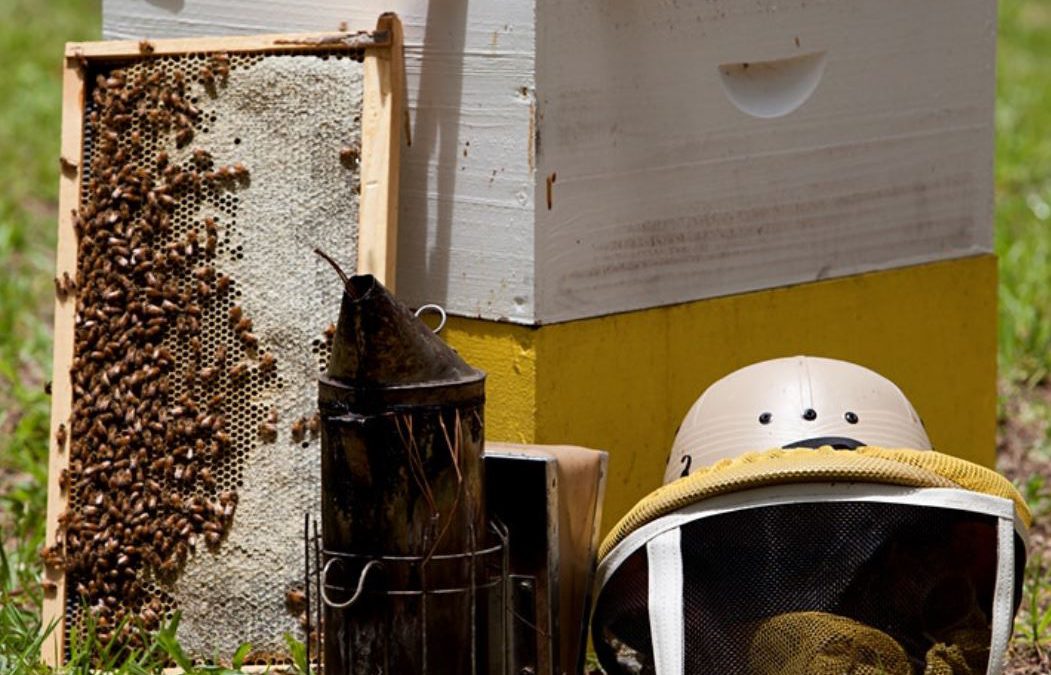
by Ray Bodrey | Apr 22, 2022
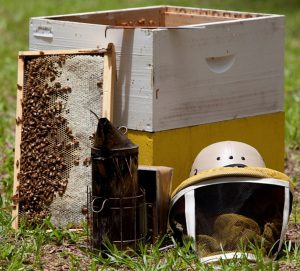
The University of Florida IFAS Extension and the Beekeeping in the Panhandle Working Group has once again teamed up to offer the 9th Annual Beekeeping in the Panhandle Conference on Friday May 6th and Saturday May 7th 2022 at the Washington County Ag Center Auditorium.
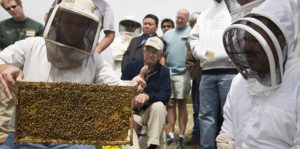
This year’s event will feature: Hands-on open hive experiences, presentations on the latest in research-based beekeeping management practices, interaction with expert beekeepers, vendors with beekeeping equipment, and hive products. Door prizes will be available as well!
The registration fee for the event will be $35 for one day or $55 for both days per person over 12, and $15 per day for kids 12 and under.
The activities will take place from 8:00 am – 5:00 pm Central each day and will include catered lunch.
Location: 1424 Jackson Avenue, Chipley, FL
Ways to register:
Registration link: https://www.eventbrite.com/e/9th-annual-beekeeping-in-the-panhandle-conference-trade-show-tickets-269199873067
Or, drop by the Washington County Extension Office in Chipley.
For more information contact Washington County Extension Office at (850) 638-6180
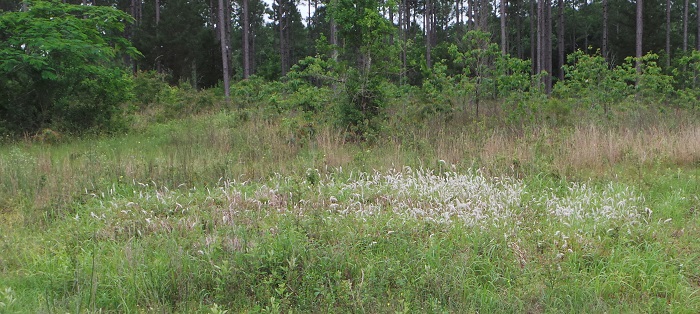
by Jennifer Bearden | Mar 26, 2021
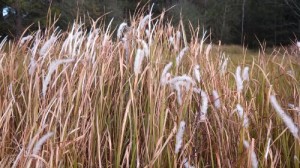
Cogongrass flowering
We’re waging war on an invasive weed, Cogongrass. Cogongrass was accidently brought into Mobile, Alabama in the early 1900’s as packing material. It was later planted in Florida and other states as a potential forage and soil stabilizer. It has low forage value and is on the Federal Noxious Weed List.
This weed can spread through both creeping rhizomes and seeds. It quickly displaces desirable grasses and plants. The roots of Cogongrass may produce allelopathic chemicals helping it out-compete other plants for space. It is drought and shade tolerant. A single plant can produce 3,000 seeds. Cogongrass is yellow/green in color with an off-set midrib and a fluffy white seed head and it grows in circular colonies.
Mowing and burning will not eradicate Cogongrass instead doing so while the plants are flowering can cause spread of seeds. Herbicide options are non-selective and kill most native ground cover such as grasses. Ridding an area of a Cogongrass infestation requires intensive management. For small infestations (less than 20-30 feet in diameter), treat the area with glyphosate once in the fall and once in the spring for 3 years (or until eradicated). For larger infestations, a more integrated approach may be necessary. Deep tilling of the soil may help in some cases.
Cogongrass is not easy to control. It takes a coordinated effort from government agencies and private landowners to work together to rid an area of this invasive weed. For more information, you can go to https://edis.ifas.ufl.edu/wg202 or contact your local extension agent.

by Rick O'Connor | Mar 26, 2021
Six Rivers “Dirty Dozen” Invasive Species
Cogongrass (Imperata cylindrica)

A relatively new patch of cogongrass recently found in Washington County.
Photo Credit: Mark Mauldin
Define Invasive Species: must have all of the following –
- Is non-native to the area, in our case northwest Florida
- Introduced by humans, whether intentional or accidental
- Causing either an environmental or economic problem, possibly both
Define “Dirty Dozen” Species:
These are species that are well established within the CISMA and are considered, by members of the CISMA, to be one of the top 12 worst problems in our area.
Native Range:
Cogongrass is from southeast Asia.
Introduction:
It was accidentally introduced as an “escapee” from satsuma crates brought to Grand Bay, Alabama in 1912. It was later intentionally introduced into Mississippi in the 1920s as a forage crop and then to Florida in the 1930s for both forage and soil stabilization.
EDDMapS currently list 79,134 records of this plant. All are listed in the southeastern U.S. Most are in Florida and Alabama, but there are records from Mississippi, Louisiana, Texas, Georgia, North and South Carolina.
Within our CISMA there are 13,279 records. This is probably underreported.
Description:
Cogongrass is a perennial grass that can vary in color from a bright-light green when young to a brown-orange when older. It does die back in areas with cold winters and heavy frost and becomes brown. The leaves emerge from the ground in clumps and can reach four feet in height. The blades are 0.5-0.75 inches wide and the light-colored midline is off center. The blades are serrated along the edge. In the spring the grass produces large white colored fluffs of seeds extending above the leaves to be carried by the wind. There are numerous small seeds joined on long hairs of these structures. There is an extensive rhizome system beneath the ground that can contribute to short distance spread.
Issues and Impacts:
The plant spreads aggressively and has been found in ditches, along roadsides, in pastures, timberlands, golf courses, empty lots, and even on barrier islands. It spreads both by seed wind dispersal and rhizome fragmentation. The plant is known to be allelopathic, desiccating neighboring plants and moving in. It can form dense monocultures in many areas.
The serrated edges of the leaves make it undesirable as a livestock forage, a fact not detected until the plant was established. It can cover large areas of pasture making it unusable. In the winter the plant becomes brown and can burn very hot. Timberland that has been infested with cogongrass can burn too hot during prescribed burns actually killing the trees.
It is currently listed as one of the most invasive plants in the United States. It is a federal and state noxious weed, it is prohibited all across Florida and has a high invasion risk.
Management:
The key to controlling this plant is destroying the extensive rhizome system. Simple disking has been shown to be effective if you dig during the dry season, when the rhizomes can dry out, and if you disk deep enough to get all of the rhizomes. Though the rhizomes can be found as deep as four feet, most are within six inches and at least a six-inch disking is recommended.
Chemical treatments have had some success. Prometon (Pramitol), tebuthurion (Spike), and imazapyr have all had some success along roadsides and in ditches. However, the strength of these chemicals will impede new growth, or plantings of new plants, for up to six months. This can lead to erosion issues that are undesirable. Glyphosate has been somewhat successful, and its short soil life will allow the planting of new plants immediately. Due to this however, it may take multiple treatments over multiple years to keep cogongrass under control and it will kill other plants if sprayed during treatment.
Most recommend a mixture of burning, disking, and chemical treatment. Disking and burning should be conducted in the summer to remove thatch and all older and dead cogongrass. As new shoots emerge in late summer and early fall herbicides can then be used to kill the young plants. Studies and practice have found complete eradication is difficult. It is also recommended not to attempt any management while in seed (in spring). Tractors, mowers, etc. can collect the seeds and, when the mowers are moved to new locations, spread the problem. If all mowing/disking equipment can be cleaned after treatment – this is highly recommended.
For more information on this Dirty Dozen species, contact your local extension office.
References
Cogongrass, University of Florida IFAS Center for Aquatic and Invasive Plants
https://plants-archive.ifas.ufl.edu/plant-directory/imperata-cylindrica/
Imperata cylindrica. University of Florida IFAS Assessment.
https://assessment.ifas.ufl.edu/assessments/imperata-cylindrica/.
Early Detection and Distribution Mapping System (EDDMapS)
https://www.eddmaps.org/
Six Rivers CISMA
https://www.floridainvasives.org/sixrivers/
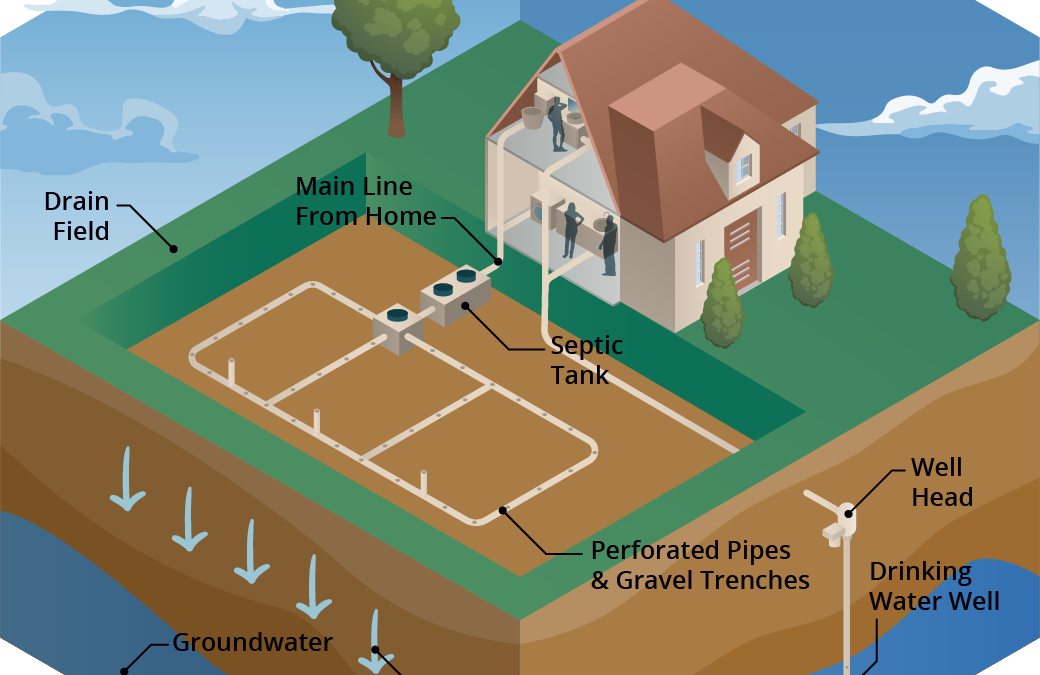
by Andrea Albertin | Jan 28, 2021
Senate Bill 712 ‘The Clean Waterways Act’ was signed into Florida law on June 30, 2020. The purpose of the bill is to better protect Florida’s water resources and focuses on minimizing the impact of known sources of nutrient pollution. These sources include septic systems, wastewater treatment plants, stormwater runoff as well as fertilizer used in agricultural production.

Senate Bill 712 focuses on protecting Florida’s water resources such as Jackson Blue Springs/Merritt’s Mill Pond, pictured here. Credit: Doug Mayo, UF/IFAS.
What major provisions are included in SB 712?
Primary actions required by SB712 were listed in a news release by Governor Desantis’ staff in June 2020 as:
- Regulation of septic systems as a source of nutrients and transfer of oversight from the Florida Department of Health (DOH) to the Florida Department of Environmental Protection (DEP).
- Contingency plans for power outages to minimize discharges of untreated wastewater for all sewage disposal facilities.
- Provision of financial records from all sanitary sewage disposal facilities so that DEP can ensure funds are being allocated to infrastructure upgrades, repairs, and maintenance that prevent systems from falling into states of disrepair.
- Detailed documentation of fertilizer use by agricultural operations to ensure compliance with Best Management Practices (BMPs) and aid in evaluation of their effectiveness.
- Updated stormwater rules and design criteria to improve the performance of stormwater systems statewide to specifically address nutrients.
How does the bill impact septic system regulation?
The transfer of the Onsite Sewage Program (OSP) (commonly known as the septic system program) from DOH to DEP becomes effective on July 1, 2021. So far, DOH and DEP submitted a report to the Governor and Legislature at the end of 2020 with recommendations on how this transfer should take place. They recommend that county DOH employees working in the OSP continue implementing the program as DOH-employees, but that the onsite sewage program office in the State Health Office transfer to DEP and continue working from there. DOH created an OSP Transfer web page where updates and documents related to the transfer are posted.
How does the bill impact agricultural operations?
SB 712 affects all landowners and producers enrolled in the Florida Department of Agriculture and Consumer Services (FDACS) BMP Program. Under this bill:
- Every two years FDACS will make an onsite implementation verification (IV) visit to land enrolled in the BMP program to ensure that BMPs are properly implemented. These visits will be coordinated between the producer and field staff from FDACS Office of Agriculture and Water Policy (OAWP).
- During these visits (and as they have done in the past), field staff will review records that producers are required to keep under the BMP program.
- Field staff will also collect information on nitrogen and phosphorus application. FDACS has created a specific form, the Nutrient Application Record Keeping Form or NARF where producers will record quantities of N and P applied. FDACS field staff will retain a copy of the NARF during the IV visit.
FDACS-OAWP prepared a thorough document with responses to SB 712 Frequently Asked Questions (FAQ’s). It includes responses to questions about site visits, the NARF and record keeping, why FDACS is collecting nutrient records and what will be done with this information. The fertilizer records collected are not public information, and are protected under the public records exemption (Section 403.067 Florida Statutes). For areas that fall under a Basin Management Action Plan (like the Jackson Blue and Wakulla Springs Basins in the Florida Panhandle), FDACS will combine the nitrogen and phosphorus application data from all enrolled properties (total pounds of N and P applied within the BMAP). It will then send the aggregated nutrient application information to FDEP.
Details of how all aspects of SB 712 will be implemented are still being worked out and we should continue to hear more in the coming months.

by hollyober | Oct 10, 2019
Insect pests can destroy substantial quantities of crops, prompting growers to invest heavily in pesticide use. Previ

These three common species of bats in FL, GA, and AL eat insect pests notorious for causing substantial damage to crops: the Seminole bat (Lasiurus seminolus), southeastern bat (Myotis austroriparius), and evening bat (Nycticeius humeralis) (photo credits @MerlinTuttle.org).
ous research in Texas suggested that bats could reduce pesticide costs by over a million dollars within their state, due to the bats’ fondness for pests that damage cotton. Scientists at UF/IFAS recently collected evidence locally that indicates bats are providing valuable assistance with pest reduction for many of the crops grown here too.
During spring and summer of 2018 scientists at UF clarified what the common species of bats were eating in north Florida, south Georgia, and south Alabama. We investigated 161 bats across 21 counties and found that 28% of these bats ate at least one Lepidopteran (moth) pest species, 21% ate a Coleopteran (beetle) pest, and 18% ate a Hemipteran (true bug) pest. In total, 12 different species of agricultural pest species were eaten by these bats.
The moth pests consumed by bats were:
- Green Cutworm Moth (Anicla infecta)
- Tobacco Budworm (Chloridea virescens)
- Soybean Looper (Chrysodeixis includens)
- Garden Tortrix (Clepsis peritana)
- Lesser Cornstalk Borer (Elasmopalpus lignosellus)
- Corn Earworm (Helicoverpa zea)
- Beet Armyworm (Spodoptera exigua)
- Fall Armyworm (Spodoptera frugiperda)
- Red-Necked Peanutworm Moth (Stegasta bosqueella)
The beetle and true bug pests consumed by bats were:
- Hairy Fungus Beetle (Typhaea stercorea)
- Tarnished Plant Bug (Lygus lineolaris)
- Two-lined Spittlebug (Prosapia bicincta)
Three of these pests (Soybean Looper, Beet Armyworm, and Two-lined Spittlebug) were most often consumed by pregnant and juvenile bats. This is good news for growers of crops affected by these pests because you have a sound option for increasing the likelihood of bats helping control them. The trick is to provide the conditions that adult female bats like near the crops these pests feed on (e.g., soybeans, peanut, cotton, corn, sorghum, safflower). Most female bats pick a maternity roost in early spring. A maternity roost is a structure that provides warm, dry, dark conditions for female bats to sleep in during the day, and it is ultimately where they give birth to pups. When selecting a site to set up a maternity roost, female bats look for structures that are large enough to provide shelter for a large number of bats. A roomy structure can accommodate many bats, which allows the flightless pups to keep each other warm while the mothers fly in search of food at night. Installing a bat house like those shown here can provide conditions appropriate for a maternity colony, increasing your chances of having bats help control these insect pests.
Another useful strategy for enhancing pest control services by bats involves creating or maintaining structures that could serve as natural roost sites for bats. The natural structures bats prefer include large trees with cavities, dead and dying trees with peeling bark, oak trees with Spanish moss, and palm trees allowed to maintain their dead fronds. In agricultural areas and suburban areas these types of trees are often in short supply.
Maintaining large, old trees of a mix of species, and supplementing with bat houses, can help ensure there are plenty of roosting options for bats. This, in turn, will increase the likelihood that bats are available to assist with your pest management.
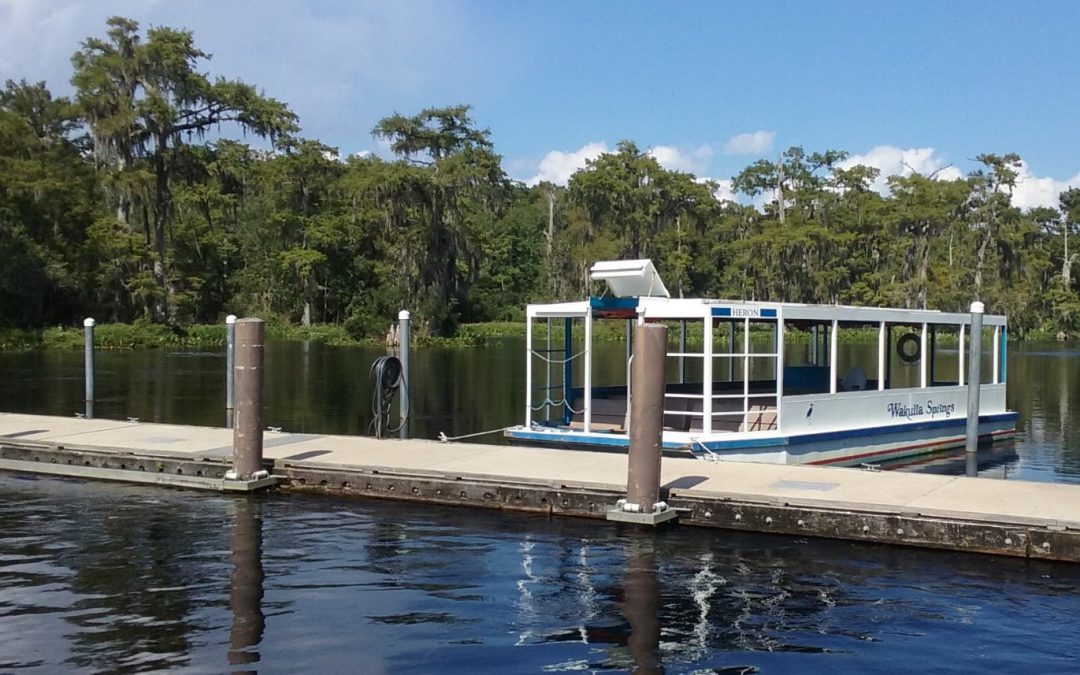
by Andrea Albertin | May 3, 2019
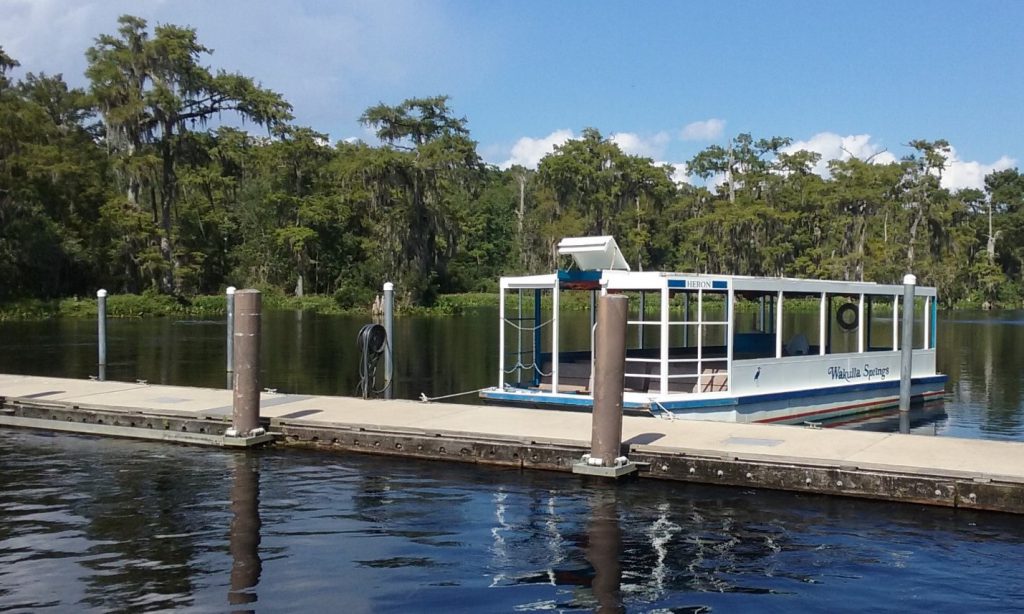
The major goal of the Wakulla Springs Basin Management Action Plan (BMAP) is to reduce nitrogen loads to Wakulla Springs. Septic systems are identified as the primary source of this nitrogen. Photo: A. Albertin
A Basin Management Action Plan, or BMAP, is a management plan developed for a waterbody (like a spring, river, lake, or estuary) that does not meet the water quality standards set by the state. One or more pollutants can impair a waterbody. In Florida, the most common pollutants are nutrients (particularly nitrate), pathogens (fecal coliform bacteria) and mercury.
The goal of the BMAP is to reduce the pollutant load to meet water quality standards set by the Florida Department of Environmental Protection (FDEP). BMAPS are roadmaps with a list of projects and management action items to reach these standards. FDEP develops them with stakeholder input. Targets are set at 20 years, and progress towards those targets is assessed every five years.
It’s important to understand that a BMAP encompasses the entire land area that contributes water to a given waterbody. For example, the land area that contributes water to Jackson Blue Springs and Merritts Mill Pond (either from surface waters or groundwater flow) is 154 square miles, while the Wakulla Springs Basin covers an area of 1,325 square miles.
BMAPs in the Panhandle
There are 33 adopted BMAPS in the state, and 5 that are pending adoption. Here in the Panhandle, we have three adopted BMAPS. They are the Bayou Chico BMAP in Escambia County, the Wakulla Springs BMAP in Wakulla, Leon, Gadsden and small parts of Jefferson County, and the Jackson Blue/Merritts Mill Pond BMAP in Jackson County. All three are impaired for different reasons.
- Bayou Chico discharges into Pensacola Bay and is polluted by fecal coliform bacteria. The BMAP addresses ways to reduce coliforms from humans and pets, which includes sewer expansion projects, stormwater runoff management, septic tank inspections, pet waste ordinances and a Clean Marina and Boatyard program.
- Wakulla Springs Nitrate from human waste is the main pollutant to Wakulla Springs, and Tallahassee’s wastewater treatment facility and the city’s Southeast Sprayfield were identified as the main sources. Both sites were upgraded (the sprayfield was moved), greatly reducing nitrate contributions to the spring basin. The BMAP is focused on septic systems and septic to sewer hookups.
- Jackson Blue/Merritts Mill Pond Nitrate is also the primary pollutant to the Jackson Blue/Merritts Mill Pond Basin, but nitrogen fertilizer from agriculture is identified as the main source. This BMAP focuses on farmers implementing Best Management Practices (BMPs), land acquisition by the Northwest Florida Water Management District , as well as septic tanks, recognizing their nitrogen contribution to Merritts Mill Pond.
Once all the BMAPS are adopted, FDEP states that almost 14 million acres will be under active basin management, an area that includes more than 6.5 million Floridians.
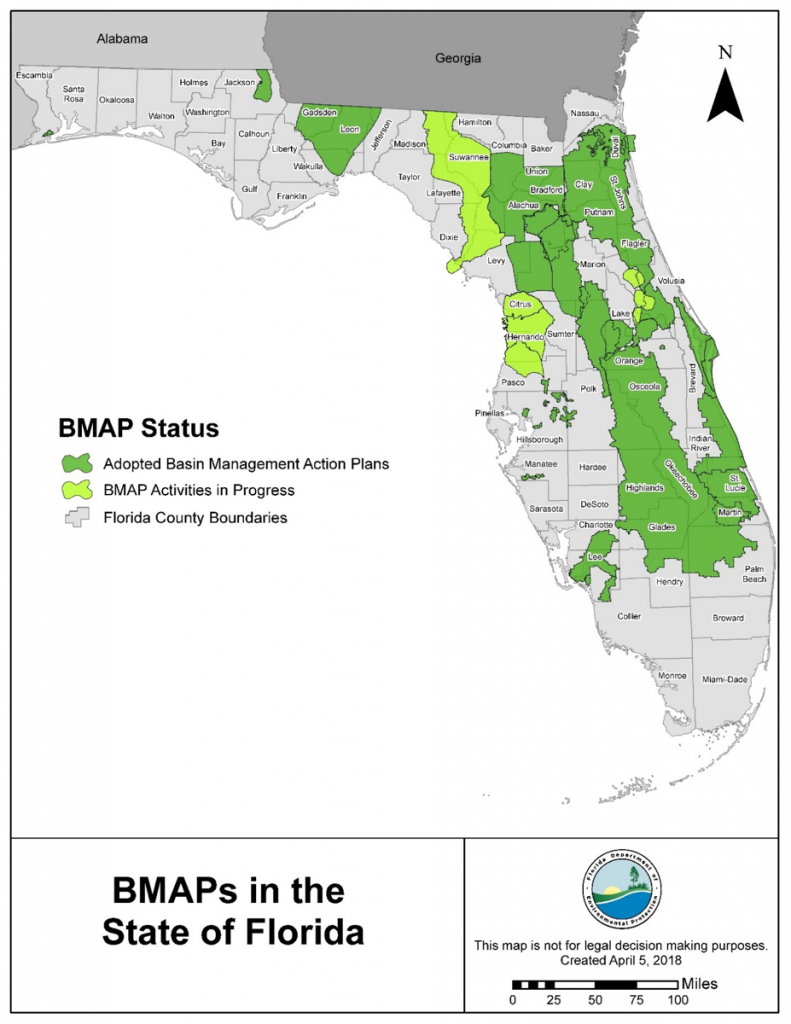
Adopted and pending BMAPS in Florida. Source: FDEP Statewide Annual Report, June 2018
How are residents living in an area with a BMAP affected? It varies by BMAP and specifically land use within its boundaries. For example, in BMAPs where nitrogen from septic systems are found to be a major source of nutrient impairment to a water body, septic to sewer hookups, or septic system upgrades to more advanced treatment units will be required in specific areas. In urban areas where nitrogen fertilizer is an important source, municipalities are required to adopt fertilizer ordinances. Where nitrogen fertilizer from agricultural production is a major source of impairment, producers are required to implement Best Management Practices to reduce nitrogen loads.
More information about BMAPS
For specific information on BMAPS, FDEP has an excellent website: https://floridadep.gov/dear/water-quality-restoration/content/basin-management-action-plans-bmaps All BMAPs (full reports with specific action items listed) can be found there, along with maps, information about upcoming meetings and webinars and other pertinent information.
Your local Health Department Office is the best resource regarding septic systems and any ordinances that may apply to you depending on where you live. Your Water Management District (in the Panhandle it’s the Northwest Florida Water Management District) is also an excellent resource and staff can let you know whether or not you live or farm in an area with a BMAP and how that may affect you.













